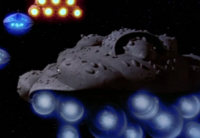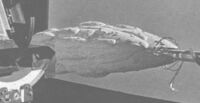MC80a Star Cruiser
The MC80a Star Cruiser, also known as MC80A Star Cruiser, was a general classification for a group of early MC80 Mon Calamari Star Cruisers converted from luxury starships into warships.
Characteristics
Built initially as massive pleasure craft by Mon Calamari shipyards, the MC80a Star Cruisers received a series of crucial upgrades to allow them to operate against Imperial warships. The addition of the Mon Calamari provided the Rebel Alliance with their first consistent source of large, powerful capital warships.

Rounded and organic in appearance, most MC80a cruisers were oblong cigar-shaped vessels. The surface of the cruisers was dotted in pods and bulges that contained sensor arrays, weapons batteries, deflector shield generators, and observation decks. Their thrusters were arranged with several on the ventral side close to the bow and several on the dorsal side close to the stern.
The MC80a Star Cruiser's role as the center of most Rebel Alliance fleet formations often pitted it against the larger and more powerful Imperial-class Star Destroyer. While unable to match the Star Destroyers in weaponry, the MC80a could outlast them in terms of defense due to triple-layered shields, multiple redundant back-up shield generators, and double-redundancy critical systems. These features, combined with a heavily armored hull and structural fortification, allowed an MC80a to absorb large amounts of damage while other fleet elements either fled or engaged enemy vessels.
Despite this incredible defensive ability, the MC80a required extensive pre- and post-battle maintenance. This task was exceedingly difficult for resource-strapped Alliance engineers, especially due to the Mon Calamari penchant for artistry, aesthetics, and uniqueness of each ship: extensive time was required to understand each ship's unique systems and operations before it could be repaired. This was eventually rectified in the standardized MC90 Star Cruiser design.
Subclasses
While no two MC80 series vessels were exactly the same, most Star Cruisers shared a similar baseline level of protection, weaponry, and features. There were even subclasses among the designs.
Most MC80a cruisers measured approximately 1,200 meters in length and required a crew of roughly 5,400. A TriLuna 400MGS stardrive and hyperdrive system achieved a Class 1 hyperdrive rating, while a Serridge SEAL Shielding System provided up to 240 SBD in shield ratings.
Weaponry was guided by a Plat Dromma targeting computer, and included 20 ArMek SW-7 ion cannon batteries, 6 front-mounted Phylon Q7 tractor beam projectors, and 48 Taim & Bak XV9 turbolaser batteries.

MC80a cruisers also included at least six starfighter bays and one auxiliary bay. These bays housed several shuttlecraft and freighters and six starfighter squadrons, which generally included one squadron of interceptors, two space superiority fighter squadrons, and three bomber squadrons. A light ground assault force was also common, which included a mixture of repulsor tanks, light assault vehicles, and 1,200 troops.
The standard fighter complement included one A-wing, two X-wing, and three Y-wing squadrons.[6]
A larger MC80a subclass was distinguished by a sleeker profile. They were 1,300 meters long. They required a larger crew than other MC80a models, with 200 additional gunners operating the ship's weaponry. Each vessel carried 1,200 troops and three starfighter squadrons.[9]
Another subclass, exemplified by the Naritus, had no dorsal thrusters, but instead what appeared to be a command pod near its stern.[2]
History

By 4 ABY, this starship was incorporated into the Alliance Fleet of the Rebel Alliance and was active during the Galactic Civil War. After a rescue on Tatooine for Han Solo, a contingent of Alliance starships converged for a high-level meeting in order to establish the plan of attack against the second Death Star at Endor, and personnel met on Home One.[7]
One of these vessels was situated near Home One prior to the fleet's jump to Endor. The engagement erupted into the Battle of Endor, which resulted in an Alliance victory, and at least six of the vessels survived the battle.[7]
Behind the scenes

The wingless Mon Calamari starship first appeared, albeit unidentified, in the 1983 Star Wars saga film, Star Wars: Episode VI Return of the Jedi.[7] While working on the film, Industrial Light & Magic model artists wanted to pad out the Rebel fleet, which was achieved by modifying their original wingless model into the Liberty type by adding wings and replacing one engine with another pod.[10][11]
The information on MC80a cruisers is contradictory: some sources say it's a design found before the Battle of Yavin, while others say it was a New Republic design and therefore at least post–Battle of Endor. The text above is a combination of the information from both sources: the history is from pre-Yavin sources, the stats from post-Endor sources. A summary of the different MC80a sources:
- Heir to the Empire Sourcebook (1992)—post-Endor. The section in the sourcebook about the Mon Calamari cruisers is essentially a repeat of what can be found in earlier sourcebooks, with the word "Rebel" changed to "New Republic." Though this seems to suggest that MC80a's are made after Endor, it does not rule out that the Rebellion also had MC80a's. Also, the term "MC80a" can only be seen in the stats section. Strangely, the text paragraph still talks about "MC80." Furthermore, the image used in the Heir to the Empire Sourcebook is the same as the MC80 image in previous sourcebooks.
- Star Wars: X-Wing (1993)—pre-Yavin. The storyline of this game leads up to the Battle of Yavin, and the game has MC80a cruisers (Independence and Defiance); the models for these ships look suspiciously like Home One. It appears that the game makers interpreted the info on MC80a's from the Heir to the Empire Sourcebook as being Rebel cruisers as well (the X-wing game borrowed many other starship designs from the West End Games sourcebooks).
- The Essential Guide to Vehicles and Vessels (1996)—post-Endor. This guide explains that "a number of more powerful cruisers (more powerful than an MC80), including the MC80a, MC80B, and MC90, are being built." While this is not very strong evidence, the text does seem to suggest that the MC80a is a newer starship design.
- The Thrawn Trilogy Sourcebook (1996)—post-Endor. This book has the same information as the Heir to the Empire Sourcebook mentioned above.
- Star Wars: X-Wing vs. TIE Fighter (1997)—pre-Yavin (actually pre-Endor). This game again features the MC80a, and is set in the period around the original trilogy.
- Cracken's Threat Dossier (1997)—arguably. The sourcebook mentions a cruiser, Naritus, featured in the novel Assault at Selonia, which then appears to be an MC80a in this matching sourcebook. The ship is described as an "aging" cruiser. Depending on what is considered "aging," the ship is at least 14 years old (post-Endor) or at most 18 years old (pre-Yavin).
- Star Wars: X-Wing Alliance (1999)—pre-Yavin (actually pre-Endor). Again Independence and Defiance are featured in this game as MC80a cruisers.
- The Essential Guide to Warfare states that MC80A was a new "lean, combat-focused variant cruiser" and construction of these ships began after MC80 liners have been refitted for combat duty (which places it after 1 BBY). The MC80A now corresponds to the "wingless" cruisers seen in Return of the Jedi, per the authors' endnotes.[12]
Appearances
- Star Wars: X-Wing (First appearance)
- Star Wars: TIE Fighter
- Star Wars: X-Wing vs. TIE Fighter
- Star Wars: X-Wing Alliance
- Star Wars: Episode VI Return of the Jedi (First appearance) (Retcon)
- Heir to the Empire
- Dark Force Rising
- Dark Force Rising audiobook
 "Retreat from Coruscant" – Star Wars Adventure Journal 7
"Retreat from Coruscant" – Star Wars Adventure Journal 7- Assault at Selonia
- The New Jedi Order: Destiny's Way
Sources
- The Rebel Alliance Sourcebook
- Heir to the Empire Sourcebook
- X-Wing: The Official Strategy Guide
- The Rebel Alliance Sourcebook, Second Edition
- TIE Fighter: The Official Strategy Guide
- Star Wars Screen Entertainment
- Star Wars Technical Journal of the Rebel Forces
- TIE Fighter: Defender of the Empire: Official Secrets & Solutions
- The Essential Guide to Vehicles and Vessels
- TIE Fighter Collector's CD-ROM: The Official Strategy Guide
- The Thrawn Trilogy Sourcebook
- Cracken's Threat Dossier
- The Official Star Wars Fact File 12 (HOM1, Home One (MC80 Mon Calamar Star Cruiser))
- The Complete Star Wars Encyclopedia
- Rebellion Era Campaign Guide
- The Essential Guide to Warfare
- Strongholds of Resistance
Notes and references
- ↑ Star Wars: X-Wing Alliance
- ↑ 2.00 2.01 2.02 2.03 2.04 2.05 2.06 2.07 2.08 2.09 2.10 2.11 2.12 2.13 2.14 2.15 2.16 2.17 2.18 2.19 2.20 2.21 2.22 2.23 2.24 2.25 2.26 Cracken's Threat Dossier
- ↑ 3.00 3.01 3.02 3.03 3.04 3.05 3.06 3.07 3.08 3.09 3.10 Heir to the Empire Sourcebook
- ↑ West End Games
- ↑ Wizards of the Coast
- ↑ 6.0 6.1 6.2 6.3 6.4 6.5 6.6 6.7 6.8 X-Wing: The Official Strategy Guide
- ↑ 7.0 7.1 7.2 7.3 Star Wars: Episode VI Return of the Jedi
- ↑ Star Wars: X-Wing
- ↑ Star Wars: X-Wing vs. TIE Fighter
- ↑ July 1983 issue of CINEFEX.
- ↑ Star Wars: Chronicles
- ↑
 Jason Fry's Dorkery — EG to Warfare: Endnotes Pt. 12 on Tumblr (backup link)
Jason Fry's Dorkery — EG to Warfare: Endnotes Pt. 12 on Tumblr (backup link)